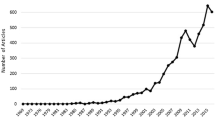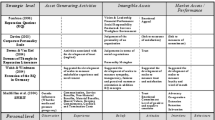Abstract
This essay provides the background story on the role that Corporate Reputation Review and its conference, Corporate Reputation, Identity, and Competitiveness played in my research and thinking on corporate reputation as a scholarly endeavor. In particular, this essay discusses the 3rd conference, (including access to the papers, presentations, and speakers), offline discussions with attendees, and the meeting of the minds between Fombrun, van Riel, and Max McCombs, one of the co-authors of the original study on agenda-setting theory. A brief description of the pivotal projects and outcomes of that meeting are discussed.
Similar content being viewed by others
References
Alsop, R. (2001a). Corporate reputations are earned with trust, reliability. The Wall Street Journal, pp. Marketplace Section, Page 1, Column B, February 7.
Alsop, R. (2001b). Survey rates companies’ reputations, and many are found wanting. Wall Street Journal, pp. Section B, Page 1, Column 2, February 7.
Barnett, M.L., E. Boyle, and N.A. Gardberg. 2000. Towards one vision, one voice: A review essay of the 3rd International Conference on Corporate Reputation, Image, and Competitiveness. Corporate Reputation Review 3 (2): 101–111.
Bennis, W., and B. Nanus. 1985. Leaders: Strategies for taking charge. New York: Harper & Row.
Berger, B.K., and B.H. Reber. 2006. Gaining influence in public relations: The role of resistance in practice. Mahwah, NJ: Lawrence Erlbaum.
Carroll, C.E. 1995. Rearticulating organizational identity: Exploring corporate images and employee identification. Management Learning 26 (4): 467–486. doi:10.1177/135050769502600404.
Carroll, C.E. 2004a. Frame. In Encyclopedia of public relations, ed. R.L. Heath, 338–340. Thousand Oaks, CA: Sage Publications.
Carroll, C. E. (2004b). How the Mass Media Influence Perceptions of Corporate Reputation: Exploring Agenda-setting Effects within Business News Coverage. (Unpublished doctoral dissertation), The University of Texas at Austin, Austin, Texas.
Carroll, C.E. 2009. The relationship between media favorability and firms’ public esteem. Public Relations Journal 3 (4): 1–32.
Carroll, C.E. 2010a. Corporate reputation and the news media: Agenda setting within business news in developed, emerging, and frontier markets. New York: Routledge.
Carroll, C.E. 2010b. Should firms circumvent or work through the news media? Public Relations Review 36 (3): 278–280. doi:10.1016/j.pubrev.2010.05.005.
Carroll, C. E. (2013). The Handbook of Communication and Corporate Reputation (1st ed.). Oxford, UK: Wiley-Blackwell Publishers.
Carroll, C. E. (2016). SAGE Encyclopedia of Corporate Reputation. Thousand Oaks, CA: Sage Publications.
Carroll, C.E., and M.E. McCombs. 2003. Agenda-setting effects of business news on the public’s images and opinions about major corporations. Corporate Reputation Review 6 (1): 36–46. doi:10.1057/palgrave.crr.1540188.
Chen, C. C., & Meindl, J. R. (1991). The construction of leadership images in the popular press: The case of Donald Burr and people express. Administrative Science Quarterly, 36(4), 521–551. http://www.jstor.org/stable/2393273.
Cheney, G.E., and L.T. Christensen. 2001. Identity at issue: Linkages between “internal” and “external” organizational communication. In New handbook of organizational communication, ed. F.M. Jablin, and L.L. Putnam, 231–269. Thousand Oaks, CA: Sage Publications.
Cheney, G.E., and S.L. Vibbert. 1987. Corporate discourse: Public relations and issue management. In Handbook of organizational communication: An interdisciplinary perspective, ed. F.M. Jablin, L.L. Putnam, K.H. Roberts, and L.W. Porter, 165–194. Newbury Park, CA: Sage Publications Inc.
Deephouse, D.L. 2000. Media reputation as a strategic resource: An integration of mass communication and resource-based theories. Journal of Management 26 (6): 1091–1112. doi:10.1177/014920630002600602.
Fombrun, C.J., N.A. Gardberg, and J.M. Sever. 2000. The reputation quotient: A multi-stakeholder measure of corporate reputation. Journal of Brand Management 7 (4): 241–255.
Fombrun, C.J., and V. Rindova. 2000. The road to transparency: Reputation management at Royal Dutch/Shell. In The expressive organization: linking identity, reputation, and the corporate brand, ed. M. Schultz, M.J. Hatch, and M.H. Larsen, 77–96. Oxford: Oxford Business Press.
Lange, D., P.M. Lee, and Y. Dai. 2011. Organizational reputation: A review. Journal of Management 37 (1): 153–184. doi:10.1177/0149206310390963.
McDonnell, M.-H., B.G. King, and S.A. Soule. 2015. A dynamic process model of private politics: Activist targeting and corporate receptivity to social challenges. American Sociological Review 80 (3): 654–678. doi:10.1177/0003122415581335.
Peters, T., and R. Waterman. 1982. In search of excellence. New York: Harper & Row.
Schultz, M., M.J. Hatch, and M.H. Larsen. 2000. The expressive organization: Linking identity, reputation, and the corporate brand. Oxford: Oxford University Press.
Tompkins, P.K., and G.E. Cheney. 1985. Communication and unobtrusive control in contemporary organizations. In Organizational communication: Traditional themes and new directions, ed. R.D. McPhee, and P.K. Tompkins, 179–210. Beverly Hills, CA: Sage.
van Riel, C.B.M. 1995. Principles of corporate communication. London: Prentice Hall.
van Riel, C.B.M. 2000. Corporate communication orchestrated by a sustainable corporate story. In The expressive organization: Linking identity, reputation, and the corporate brand, ed. M. Schultz, M.J. Hatch, and M.H. Larsen, 157–181. London: Oxford University Press.
Wartick, S.L. 1992. The relationship between intense media exposure and change in corporate reputation. Business & Society 31 (1): 33–49. doi:10.1177/000765039203100104.
Author information
Authors and Affiliations
Corresponding author
Rights and permissions
About this article
Cite this article
Carroll, C.E. Corporate Reputation and the News Media: The Origin Story. Corp Reputation Rev 20, 165–170 (2017). https://doi.org/10.1057/s41299-017-0038-z
Published:
Issue Date:
DOI: https://doi.org/10.1057/s41299-017-0038-z




